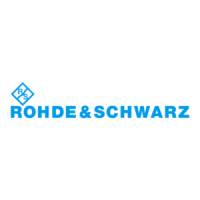Command reference
R&S
®
ZNA
973User Manual 1178.6462.02 ─ 20
Parameters:
<Boolean> ON | OFF - Limit line on or off.
*RST: OFF
Example:
*RST; :CALC:LIM:CONT 1 GHZ, 2 GHZ
Define an upper limit line segment in the stimulus range
between 1 GHz and 2 GHz, using default response values.
CALC:LIM:DISP ON
Show the limit line segment in the active diagram.
Manual operation: See "Show Limit Line" on page 431
CALCulate<Chn>:LIMit:FAIL?
Returns a 0 or 1 to indicate whether or not the limit check has failed. 0 represents pass
and 1 represents fail
Tip: Use CALCulate:CLIMits:FAIL? to perform a composite (global) limit check.
Since V2.20 of the R&S ZNA FW the result is automatically recalculated whenever a
relevant setting is changed, i.e. a subsequent query will return the updated limit viola-
tion state.
Suffix:
<Chn>
.
Channel number used to identify the active trace
Example:
*RST; :CALC:LIM:CONT 1 GHZ, 2 GHZ
Define an upper limit line segment in the stimulus range
between 1 GHz and 2 GHz, using default response values.
CALC:LIM:STAT ON; FAIL?
Switch the limit check on and query the result.
CALC:LIM:STAT:AREA LEFT, TOP
For a subsequent check at the GUI or a hardcopy, move the
pass/fail message to the top left position.
Usage: Query only
Manual operation: See "Limit Check" on page 432
CALCulate<Chn>:LIMit:LOWer[:DATA] <ResponseValue>, <ResponseValue>...
CALCulate<Chn>:LIMit:UPPer[:DATA] <StartResponse>,
<StopResponse>[,<StartResponse>, <StopResponse>[,...]]
Sets/gets the response (y-axis) values of the lower/upper limit lines and/or creates new
limit line segments. See also Chapter 4.4.1.1, "Rules for limit line definition",
on page 141.
Note that in contrast to commands addressing a single limit line segment <Seg> (such
as CALCulate<Chn>:LIMit:SEGMent<Seg>:TYPE), these commands assume
that
●
lower limit line segments are assigned even numbers (<Seg> = 2,4,6,...) and
●
upper limit line segments are assigned odd numbers (<Seg> = 1,3,5,...).
SCPI command reference

